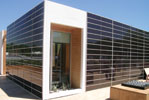

The Solar Decathlon is sponsored by the US Department of Energy, and challenges 20 college teams to design, build, and operate solar powered houses that are cost effective, energy efficient, and attractive. The first Solar Decathlon was held in 2002, and since 2005 has been held in the USA every two years. In 2010, following an agreement with the Spanish Government, the Solar Decathlon Europe was introduced, and will run in alternate years to the original competition.
Universities from Europe, America and Asia took part in the Solar Decathlon Europe 2010, held in Madrid. During the 10-day event, more than 190 000 people visited the Villa Solar, the name given to the site near the Palacio Real. The 17 teams were each tasked with designing and building energy efficient homes that were both habitable and economically feasible. Homes were assessed in 10 different categories, ranging from affordability to engineering and visitors were asked to pick their favourite.
Viable and popular
The home developed by the Cardenal Herrera CEU University of Valencia was awarded the highest number of votes by visitors. It also scored well in a number of assessment categories, including industrialisation and market viability, where it won first prize, and in architecture, engineering, construction and innovation.
Sustainability of the house was based on five key attributes: the use of solar power; reduced energy consumption; increased energy efficiency; the use of
non-hazardous, re-usable and environmentally sustainable materials; and optimised water use. Comfort (one of the assessment categories) was achieved through passive bioclimatic systems including natural lighting and cross-ventilation.
Several innovative solutions were developed to minimise energy consumption, such as integrating solar panels into the house’s façades. In addition, the 70 square metre roof has a hybrid system of fixed solar energy collectors and overlapping photovoltaic units.
These automatically unfold to meet the house’s energy needs at any particular time, and combine three different systems:
* Hybrid photovoltaic and photo-thermal blocks, which make the solar energy collection more flexible.
* Purely thermal blocks with concentrating mirrors, to provide hot water.
* Purely photovoltaic blocks.
The thermal roof can be maximised during the winter months to enable the solar collectors to make the most of even diffuse radiation. When heating is not required, the roof can be used to collect photovoltaic energy for later use.
Climate control using solar cooling
A solar cooling system was developed to provide internal climate control, with hot rising air being cooled through cold water pipes that run through the ceiling of the house. This cold water comes from an absorption machine that is fed with water at 90°C from the house’s solar collection thermal system. This ‘virtuous circle’ supports the designers’ objective of zero energy consumption.
The house featured a thermal oven. This has a series of oil-carrying pipes, with the fluid heated by solar thermal collectors. The latest version of this oven, which uses food-grade oil, can deliver temperatures of up to 240°C.
Through its office in Valencia, Omron Electronics Iberia collaborated closely with the university on the development of the house. In addition to technical advice, Omron supplied innovative and advanced control equipment – CJ1 PLCs, and NS5/NS10 programmable touch-screen terminals – which manage the energy distribution and the intelligent roof.
The house also featured a thermal oven with a series of oil-carrying pipes, with the fluid heated by solar thermal collectors. The latest version of this oven, which uses food-grade oil, can deliver temperatures up to 240°C. An Omron frequency inverter controls the speed of the oil in the oven, the operation of which is managed by a NS5 programmable terminal. Both devices are connected to an Omron CJ1 PLC.
For more information contact Terry McIntosh, Omron Electronics, 086 066 7661, [email protected], www.industrial.omron.co.za
| Tel: | +27 11 579 2600 |
| Email: | [email protected] |
| www: | www.industrial.omron.co.za |
| Articles: | More information and articles about Omron Electronics |

© Technews Publishing (Pty) Ltd | All Rights Reserved